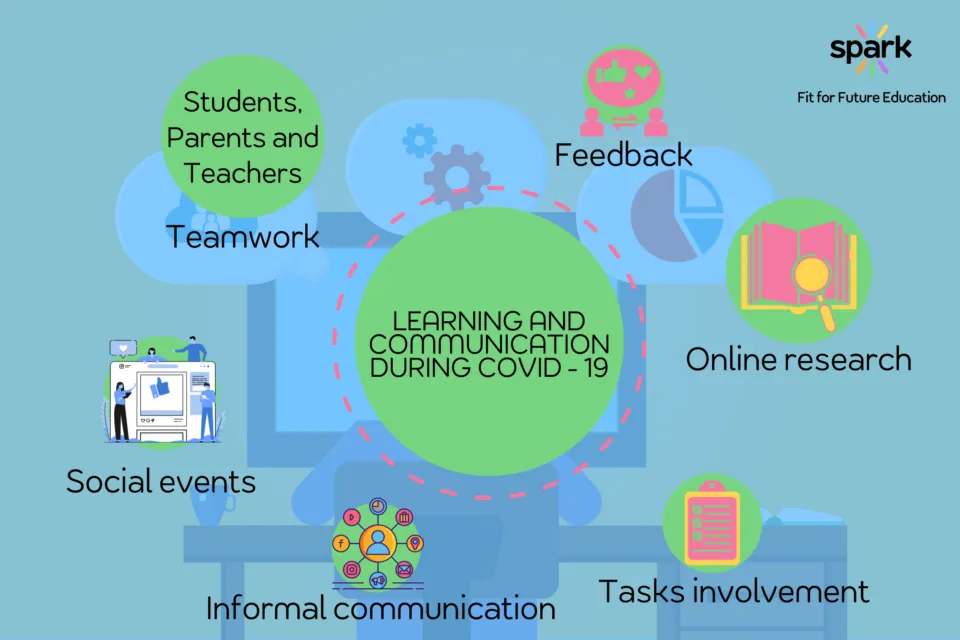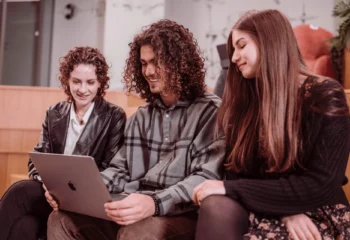We live in a world where we have to change and adapt to the new reality. The pandemic formed this reality for almost two years now and continues to be the drive-in our lives. What we do, how we study, and communicate is all related to the COVID – 19 pandemic. And why wouldn’t it be?
The concept of distance education is not new, but it has become a natural learning style. It has four main components – a corporate basis, interactive telecommunication, data sound and video sharing as learning experiences and communications and the physical separation of teachers and students. (Burns, 2011)
The right to education is for everyone, and during COVID – 19 crisis, especially, international educational policies are essential for the consolidation of the government response capacity and the sustainability of the education.
The context of the education during the pandemic
The process of teaching and learning has been directly affected and the interaction between teachers and students alike. While online learning has been an option for many years now – distance education forms date back to 1840, when Isaac Pitman used the mail to connect with students (Bezhovski, Z. et. Al., 2016, The Evolution of E-learning and New Trends), making it a must and fully online, is different. This is why students’ perception has shifted as far as it is concerned. And the last year, when many schools moved to mainly online courses for when the pandemic hit its peak, it took a toll on many students.
A good explanation for this is that neither of them nor the teachers, nor the students were prepared for a total shift to online. Teachers had to adapt their learning styles totally, and students had to get used to the reality of
– Spending too many hours in front of the screen
– Not enough non – digital activities
– The frustration for some that do not have internet access or a good computer system
– Lack of communication and interactions with teachers and peers. (Aboyage, E. et al., 2020, COVID – 19 and E-learning: The Challenges of Students in Tertiary Institutions)
Besides the above, there are additional issues as far as learning and communication concerns during COVID – 19 such as – students and children who do not have access to a household computer, do not have internet access at home or the locations they live in are not served by mobile networks. The pandemic needs to make sure these children are also taken into consideration and, keeping this in mind, find the best solution for them.
Improving the e-learning process?
How can the e-learning process be developed to benefit both students and teachers, and more than this, it can create the communication path students have been looking for when fully learning online?
Currently, the e-learning process can be improved by:
– Methods to deliver the course
– Time spend to complete the tasks
– The content
What students do not know and teachers were not prepared is that some principles stand at the core of successful online teaching:
– Boosting contact between students and school
– A two-way learning
– Quick feedback
– Active learning
– Allocate more time to completing tasks
– Communication of expectations to maintain the encouragement and motivation in students
– Varied learning
– Technology application (Cheung, C. et al., 2017, Eight Principles of Effective Online Teaching: A Decade-Long Lessons Learned in Project Management Education)
Is Hybrid education an option?
Hybrid education means a combination of online learning, e-learning and face to face learning. Given the context, face-to-face learning is the smallest part of it, but it must exist. It helps students and teachers stay connected, have open communication when needed and create a stronger connection than studying online.
Online learning, e-learning, hybrid learning – each of these options are better than no learning – in the actual context of the pandemic. While making a complete shift proved to be hard for some schools that were not prepared and did not have enough resources, overall, it is the future of learning, and we should focus on improving it and making it work to our advantage. The communication barriers can be worked with and solved.
Communication as learning concerns during COVID – 19
Before COVID – 19, communication could be easier established through direct contact and feeling the other; online learning changes this situation. Thus, teachers should prepare accordingly and understand that it is harder for students, and they need to be a support in this.

Students rely on their teachers for more than just academics – they feel the need for stability, comfort and support. Depending on technology for communication makes the above harder but not impossible. The dynamic is shifting, and both teachers and schools need to do their best to continue good communication with their students.
Effective communication is essential in all areas, and maintaining a healthy mind and body implies good communication. Our social skills need to be fed, and finding the right solution helps with their development. Retaining the human touch in this digitized world where even teaching has turned online is an essential part.
The communication between students and teachers and between teachers and parents can continue with the right mindset and the needed tools. Regardless of the format, the channel of communication needs to be planned and support the student learning.
The online opportunity of communicating is a good change from many aspects :
– The reach of a broader parent and students community
– It is faster
– The easier accessibility
– It can be interactive if we want
Regular communication is essential for all – the students, the school, the teachers and the parents. And adopting the communication tools we have at our disposal – such as email, videos, phone calls is helpful to keep the communication alive.
While sometimes the above may not seem enough, considering the benefits and the root cause of online learning during COVID – 19 will help one ease the mind and embrace this change.
Communication at Spark School
As a hybrid high school, Spark wants to come to the help of its students. Whether this pandemic situation or not, we are prepared and make continuous efforts to sustain our students in their need for communication with their peers and teachers, their need for stability and comfort.
We do this by having a modern and innovative learning model that improves every time; our teachers are trained in online learning and have the best tools to make learning smooth. We offer
– Online support and learning development opportunities
– Group/class circles with teachers and peers
– Regular feedback to the students to keep them updated with their work
– Wellbeing workshops for both the students and their families
– Weekly group interactions with pastoral mentors
– Weekly meetings with academic tutors
– 30 Live Assembly for all students (weekly)
– Social events – quiz night etc.
– Student-led conferences
We are continuously developing the communication channels between students and teachers according to their needs.
Conclusion
May it be hybrid or e-learning, the reality is that it is a needed learning option, and it can bring many benefits to the students. It is flexible; it can adapt the courses to the needs of each student, it gives students the option to learn at their rhythm, it motivates students to interact with peers and more than ever, it saves time. As the world is spinning around us, having extra time without commuting to and from school is a blast. Of course, it has disadvantages like a lower level of focus or engagement from the student’s perspective. But we need to start thinking of “school” in different ways and understand that sometimes the face to face school cannot happen.
As far as bridging the digital divide in education, the Close the Gap project works towards this. We can all participate in this project and help children have access to education if online is the go-to option for now.
According to a study (Coman, C. et al., 2020, Online Teaching and Learning in Higher Education during the Coronavirus Pandemic: Students’ Perspective), 41.3 % of the interviewees would choose a combination of online and offline courses, while 10.6 % would prefer only online teaching.
The success of students requires time and trusting relationships. In this pandemic situation, let us try and make the best of it and accept it while readjusting our ways of communication. Developing a trusting relationship through mere listening and showing students teachers are only a click away helps. Many students agree that being available through social media channels or more modern ways of communication help a lot.
While online learning proved to harm the communication between students and teachers, building opportunities to keep communication alive makes the difference. Keep in touch through online channels, have 1:1 meetings and discussions, also use informal communication channels.




